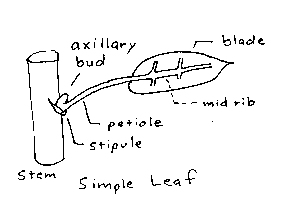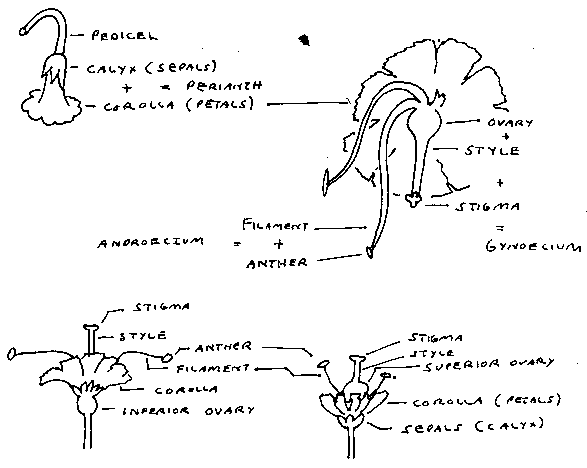SC/SS 115 Ethnobotany test two • Name:
Sketch one of the leaves in the laboratory. To the best of your ability, label the parts of the leaf. Include whether the leaf is most likely from a dicot or monocot.
 The stalk was that of Alpinia carolinensis, an indigenous giant ginger that is unique to Pohnpei. Locally the plant is called ieuieu, and although the plant is uniquely Pohnpeian, not a single student including those from Pohnpei were able to identify this rare and unusual plant. Ieuieu is a monocot and the leaf lacks an auxillary bud and stipules. The lack of an axillary bud is typical for gingers and bananas with one consequence being that stem cuttings cannot be planted and grown as one does with Piper methysticum (sakau), sugar cane (Saccharum officinarum), or tapioca (Manihot escuelenta).
The stalk was that of Alpinia carolinensis, an indigenous giant ginger that is unique to Pohnpei. Locally the plant is called ieuieu, and although the plant is uniquely Pohnpeian, not a single student including those from Pohnpei were able to identify this rare and unusual plant. Ieuieu is a monocot and the leaf lacks an auxillary bud and stipules. The lack of an axillary bud is typical for gingers and bananas with one consequence being that stem cuttings cannot be planted and grown as one does with Piper methysticum (sakau), sugar cane (Saccharum officinarum), or tapioca (Manihot escuelenta).
Sketch one of the flowers in the laboratory. Correctly identify the four whorls, labeling the parts of the flower to the best of your ability. Include whether the flower is a dicot or monocot.
 The flower is from Merremia peltata (iohl, puhlah). The five anthers and pentagonal corolla are clear indications that this is a dicot.
The flower is from Merremia peltata (iohl, puhlah). The five anthers and pentagonal corolla are clear indications that this is a dicot.
Essay Question Comments
Comments in random order
Mechanics
While syntax and grammar were weaker than vocabulary, there was also a lack of organization and structure to many essays. Many lacked a true introductary paragraph or a concluding paragraph. Many essays appeared to simply end when the writer ran out of ideas on what to say. An essay should have an introductory paragraph, two or more body paragraphs, and a conclusion. This essay could easily have had four to five body paragraphs structured around the key points. Some refer to this structure as, "Tell them what you are going to tell them, tell them, then tell them what you told them."
Material Culture does not need to be capitalized. Modern style manuals usually specify a "decapitablized" style of writing.
Students had a lot of difficulty with pronouns, specifically pronouns that lacked a clear antecedent. Consider the following sentence, "A mother and daughter walked to the store. She fell down and cut her leg." Who fell down? In English there is no way to determine who fell down. We say that the pronoun (she) has no clear antecedent (ante- means "before"). Another example, "The mothers teach their daughters to make mats, but she cannot do it." While this is subtler, the antecedent remains unclear. Who cannot do what? The mothers cannot teach or the daughters cannot learn? Avoid pronouns where there might be confusion. Replace he, she, it, this, that and other pronouns with the actual antecedent.
A related rule is that a pronoun cannot appear in a paragraph where the antecedent is in the prior paragraph. Again, replace the pronoun with the original object or person.
Content
Medicinal plant use is NOT material culture. Food plants are also not material culture. Pohnpei has festivals for yams. The loss of the festivals – of the culture – would not necessarily end its use as food. China has rice festivals, but you eat the same rice without observing the festivals. The use of plants as medicine and food were not at issue in this essay, there is no doubt these will survive in one form or another. At issue is whether material cultural practices can be conserved and passed on to the next generation. A number of students wrote about the importance of food and medicine plants, I noted this as off-topic.
Many students fell into the trap of saying that material culture is important and must be conserved. Since this is an essay written from a personal point of view, filled with "I believe" and "We must" type clauses, you cannot answer that material culture is important. Obviously it is not important. Not a single student has come in a hibiscus or banana fiber skirt, neither the men nor the women are topless, no one is using a canoe to get the college, virtually none of you who live on Pohnpei walk to the college, and few of you will sleep tonight in a thatched hut.
A culture is not a committee, a culture is the result of the way individuals act and the choices they make during the day. Your daily choices make it clear that material culture is not important, therefore you cannot argue that all material culture is important and must be conserved.
The easiest argument to make is that material culture is separable from medicine, food, and ritual use of plants and can be discarded. That is at least logically consistent with the decisions you make on a daily basis.
A slightly more complex argument woud be that certain material cultural practices can be conserved and passed on, while others either have been allowed to pass or will be allowed to pass away. A related argument is that material culture will be kept alive by ensuring its usage in certain special situations, such as in the paddle dance done by the youth of Palikir on Friday at the Pohnpei Botanic Garden. If a student made this argument I looked for specific examples of what should be kept and what should be allowed to pass away.
We cannot present foods to our chiefs in plastic bags. As long as our traditional social structures survive, the making of coconut leaf baskets will survive. Some parts of material culture are probably nearly impossible to lose.
There are arguably three things that are aiding the destruction of the ethnobotanical material culture: money, time, and prestige. Call these the three horsemen of the cultural apocalypse. People now need money and modern jobs do not include passing along material culture. People find the foreign ways to be more convenient, to be time savers. It is faster to buy lumber than cut it in the forest. Here money and time intersect: you need money to save time. Some argued that laziness underlies the use of money to save time. Prestige relates to social rank. If your social rank is high, you are unlikely to want to use a canoe to cross the lagoon or ride a carabao to work. A number of students noted one or more of these as reasons for the loss of material culture.
In an earlier term one student made an interesting argument that traditional material cultural items have more intrinsic beauty. Which does the tourist photograph, the cement house or the thatched hut? Which is better looking, the coconut leaf basket or the plastic bag? Which makes a nice model for the living room table, a traditional canoe or a model of a fiberglass outboard motor boat? The loss of traditional material culture is a loss of beauty. The student then noted that it takes many people working together to make a hut or a canoe. When baskets are made the family gathers to work together. No one gathers to make plastic bags. Traditional items bring communities together in cooperative ways. This leads to social interactions. The most important social rule in any social setting in Micronesia is respect and honor. Thus the loss of the production of traditional material culture is a loss of beauty, a loss of opportunities for communal cooperation, and ultimately a loss of respect and honor. I still find this a particularly insightful and poignant point of view.
A number of students kept contradicting themselves, probably a result of the complexity of the issues surrounding the loss of material cultural practices. One student noted that it is "easy to conserve material culture" and then went on to explain that no one can be forced to anything in a democracy. This would imply that one cannot force people to conserve material culture, so how is it easy to conserve material culture? Another noted that people cannot be forced to wear traditional clothes and go topless, but if we make people understand how important material culture is, then people will want to conserve that way of life. Again, this is ultimately contradictory, doubly so as the writer has yet to wear a coconut leaf skirt to school.
One interesting idea is to run summer camps for youth where elders teach the youth the culture. Hedger Miguel (spelling?) is doing this with Project LEAP in Wone, Kitti.
Penmanship was added to the rubric when I found that some essays were very difficult to read.
| 5 | Exemplary near perfect penmanship, letters on the line, correctly formed letters, even and appropriate spacing between letters and words, legible. |
| 4 | A few inconsistencies in spacing and letter formation, penmanship is neat. |
| 3 | Frequent errors in spacing or letter formation, some difficulties in reading due to legibility. |
| 2 | Substantive, frequent errors in spacing, letter formation. Difficult to read, penmanship problematic but still decipherable. |
| 1 | Penmanship errors so fundamental and pervasive as to render the essay almost unreadable and incomprehensible. |
| 0 | Illegible scrawl. |
 The stalk was that of Alpinia carolinensis, an indigenous giant ginger that is unique to Pohnpei. Locally the plant is called ieuieu, and although the plant is uniquely Pohnpeian, not a single student including those from Pohnpei were able to identify this rare and unusual plant. Ieuieu is a monocot and the leaf lacks an auxillary bud and stipules. The lack of an axillary bud is typical for gingers and bananas with one consequence being that stem cuttings cannot be planted and grown as one does with Piper methysticum (sakau), sugar cane (Saccharum officinarum), or tapioca (Manihot escuelenta).
The stalk was that of Alpinia carolinensis, an indigenous giant ginger that is unique to Pohnpei. Locally the plant is called ieuieu, and although the plant is uniquely Pohnpeian, not a single student including those from Pohnpei were able to identify this rare and unusual plant. Ieuieu is a monocot and the leaf lacks an auxillary bud and stipules. The lack of an axillary bud is typical for gingers and bananas with one consequence being that stem cuttings cannot be planted and grown as one does with Piper methysticum (sakau), sugar cane (Saccharum officinarum), or tapioca (Manihot escuelenta).
